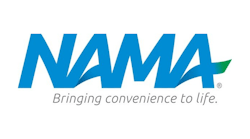The vending industry has always been on the cutting edge of ways to deliver food. From ice cold sodas available during breaks at the factory to hot coffee in the middle of the night at rest areas, vending has been pushing the boundaries of when and where food is available — often faster than regulations can keep up. Micro markets, vending’s newest addition, is no exception. After eight years, there are still only a handful of states that have written legislation licensing micro markets differently than either vending or convenience stores. Health departments are struggling to understand exactly what a micro market is and how operators can possibly protect food integrity without a person being present. This is where NAMA, the association representing the U.S. vending and refreshment services industry, has stepped in and called in an expert on food safety to proactively navigate the regulations surrounding the lucrative micro market business — Larry Eils, NAMA’s health and safety knowledge source partner.
“We are working with the U.S. Food and Drug Administration (FDA) to see how we can put micro markets into the food code,” said Eils, who has been ensuring requirements of the federal food codes were manageable for the vending industry since 1985. The food code is a model that assists food control jurisdictions at all levels of government by providing them a scientifically sound technical and legal basis for regulating the retail and food service segments. The benefits include uniform and national standards using the most current science available to reduce the risk of foodborne illness within retail.
“One of the problems is that health departments have a lot of issues with micro markets, or what are now called unattended food establishments by the FDA,” Eils said. Micro markets don’t fit into current food retail perimeters, and the fact that there is no one on site responsible to watch the food and maintain food safety has been a cause for concern. “There are several places that wanted regulations — Ohio; Indiana; Texas; Maricopa County, Arizona; County of Los Angeles, California — these departments didn’t want to wait for the federal government to provide it,” said Eils.
Josh Rosenberg, president and CEO at Austin, TX-based Accent Food Services (AFS) operates in an area which established requirements ahead of the federal agencies. However, Rosenberg was prepared. “Prior to the October 2015 requirements for a health permit, AFS had already engaged with the state’s Department of Health & Public Safety,” said Rosenberg. The company was able to be part of the decision making and education concerning the permits. “The challenge has come at the local level where jurisdiction resides,” Rosenberg said. At the local level, state requirements can be defined differently or overruled completely with stricter, more challenging ones. “I will say that the health departments are getting more involved in our space,” indicated Rosenberg. “And for us, it’s fortunate to be seen as a partner in defining, educating and addressing.”
Eils agrees that health departments are taking a more active role in micro market licensing and national regulations are inevitable. This is why micro markets were addressed by the Conference for Food Protection, a non-profit organization created to provide a formal process whereby members of industry, regulatory, academia, consumer and professional organizations are afforded equal input in the development and/or modification of Food Safety Guidance. Such guidance is incorporated into food safety laws and regulations at all levels of government throughout the U.S. In April 2016, the Council of Delegates for the Conference for Food Protection accepted finalized guidelines for unattended food establishments (micro markets) and these guidelines will likely be used by city, state and ultimately federal health and food safety organizations when licensing and regulating micro markets.
Having some federal guidance might be a positive thing, especially when operators cross state lines. For Maumee Valley Vending Co. in Defiance, OH, it has been a challenge to meet changing and strict regulations in its home state, and then varying requirements in nearby Indiana and Michigan.
“When we first started, we proactively worked with the health department to come up with food safety requirements such as wrapping fruit that didn’t have a peel, installing automatically locking coolers, etc.,” said Terry Miller, general manager at Maumee Valley Vending Co. However, two years ago, the micro markets were reclassified to be a level one restaurant, which increased the license cost and requirements significantly. Now Maumee Valley Vending Co. has to submit a 20 page plan review per market that includes things like lighting charts. “It’s more requirements than are necessary and it seems to be a problem with education,” indicated Miller. He recalls a health department director coming to a scheduled inspection at a new micro market installation. “The director got there, looked around and said ‘Is this it?’” said Miller. He knew that the director had not fully understood the concept of the micro market and that it lacked the food preparation and cooking areas restaurants and convenience stores have which increase foodborne illness risk.
In neighboring states, Miller has few, if any, requirements, but he ensures he is staying proactive with those health departments as well. “It requires vigilant, good relationships and education. They need to understand what our business is and what it is not,” said Miller.
Common sense guidelines
The recommended guidelines from the Conference for Food Protection are fairly straight forward and address the three main areas of food safety concerns: food spoilage due to high temperature/equipment failure, illegal food tampering and potential cleanliness issues that arise when no person is present. Food spoilage happens when the temperature at which food is kept rises. This is addressed in the guideline by requiring an automatic self-locking cooler/freezer, either built-into by the manufacturer or a retrofit device added afterwards. The mechanism needs to lock the cooler or freezer, preventing a consumer from purchasing potentially spoiled food in the event of a power failure or equipment malfunction that causes the temperature to rise to unsafe levels. The food could start to develop bacteria growth at dangerous levels that can cause illness. NAMA has already established a certification process for these mechanisms, and lists companies with approved models on its website (vending tab > certified companies). The Public Health and Safety Organization, NSF, also recently added language to its standard to cover unattended units that would be used in micro markets.
“If you want to sell food, you might as well buy the [right] unit,” said Eils who warns that most provided coolers from suppliers are not intended for food, but beverages. Eils also doesn’t see any stricter regulations in the works, meaning operators can reasonably guarantee that if they invest in locking coolers now, even before their local health department has regulations, the technology they buy will meet the regulations once the health department puts them in place. With the current technology available, preventing foodborne illness from bacteria affected by temperature is fairly straightforward. However, protection against food tampering isn’t as clear.
Tampering is biggest challenge
A major concern for health department officials is how micro market operators can protect people from situations that may compromise food safety or food defense, such as intentional food tampering. “It will come down to monitoring and if the FDA agrees to the idea of using video surveillance,” explained Eils.
While surveillance is widely used by operators to prevent, or at least deal with theft of products in micro markets, NAMA is arguing that it can also be used to detect and prosecute food tampering. Eils believes the association will need to provide data that having cameras reduces theft of product. It can then be argued that if theft is affected (and controlled) by surveillance, so too is tampering. “We need stats about theft and how surveillance works,” said Eils. “If theft is under control, then tampering will be under control, too. That’s the argument we will likely take with the FDA.”
Prevention of food tampering with no staff on site was one action item Rosenberg had to address with the Texas health department early on. “In line with the challenges of education about our defined business category and the State’s classification was attended vs. unattended,” said Rosenberg. “Our cameras having the ability to capture all activities within the store insulated us from food tampering surveillance and we use a sealed food package to further minimize risk...once we demonstrate the level of discipline and compliance we have at micro markets, we can typically move past any other concerns,” finished Rosenberg.
Beyond the tampering and temperature issues, is the requirement of keeping the area clean and stocked. How best to achieve this in a micro market should be left up to the operator, suggests the guidelines from the Conference for Food Protection. Multi-use food-contact surfaces shall be cleaned on a frequency consistent with the service per section 4-202. 11, of the Food Code, for example. Routine service must include checking food for signs of damage or tampering, expiration dates, recalled items, etc. Micro market operators will want to ensure the guidelines are included in their micro market driver training materials and drivers are complying with the requirements at each service.
Proactive licensing
It’s important to be proactive, in that it helps open the dialogue and encourages health departments to allow micro markets in workplaces. If an operator merely swapped micro markets for vending at a location without contacting the health department, he or she will be discovered, warns Eils. “We suggest operators visit the health department and talk about the micro market, then ask what they need to do to get a license,” said Eils. He believes that micro market operators should be prepared to pay a cost for the licensing somewhere in between a vending machine license and a convenience store license, perhaps $100 to $500, depending on the state. The license fee will cover inspection and administrative costs incurred by the health department. Micro markets have been classified as a priority 1 location, meaning they have low exposure to foodborne illnesses, so inspections will likely be yearly.
“It’s the cost of doing business,” said Eils. “The revenue is higher with a micro market, so operators will just have to build the license fee into the prices.” Eils does say that if an operator is caught without a license, there will be no jail time, or even a fine. From his experience, the health department simply makes the operator go through the process of obtaining the proper license, along with the costs of closing the market until the license is obtained.
Decades ago, health departments worried that vending machines couldn’t provide the same degree of food safety as restaurants or retail locations with on-site employees. Regulations and strict dedication to proper food handling and its transportation by operators was able to counter those fears and keep the consumer safe from foodborne illness. Micro markets are going through the same process. Federal guidelines are coming, and it’s important for micro market operators to be prepared, ready to join the educational process and comply with regulations to keep this lucrative segment of the industry going.
Guidelines For Unattended Food Establishments (Micro Markets)
Micro markets must be inside a building with controlled entry (not open to the public)
Micro markets can only sell commercially packaged food (including certified commissaries) or whole fruit
Micro markets need to require no consumer preparation other than reheating
Micro markets must have self-closing food coolers/freezers with automatic self-locking mechanisms
Micro markets need continuous video surveillance of resolution sufficient to identify situations that may compromise food safety or food defense
Micro market service is required on a scheduled basis and acceptable frequency
Micro market service is obliged to include: cleaning surfaces, verifying refrigeration equipment is operational, rotating product, restocking, checking for recalled products and visually inspecting food for tampering or damage.
For the full guidance document prepared by the Conference for Food Protection, visit http://www.foodprotect.org/guides-documents/guidance-for-unattended-food-establishments/
Take Action To Protect Micro Markets
The U.S. Food and Drug Administration will want to know how micro market operators can ensure food safety, especially in regards to preventing food tampering. If the industry can prove that video surveillance reduces incidences of theft through data, this can also show that surveillance will reduce tampering. Look for an upcoming survey or information requests from NAMA to collect this information, which could be instrumental in proving micro markets are a safe way to provide food and should be included legally in the food code.

Emily Refermat
Emily began covering the vending industry in 2006 and became editor of Automatic Merchandiser in 2012. Usually, Emily tries the new salted snack in the vending machine, unless she’s on deadline — then it’s a Snickers.
Emily resigned from Automatic Merchandiser and VendingMarketWatch.com in 2019 to pursue other opportunities.






